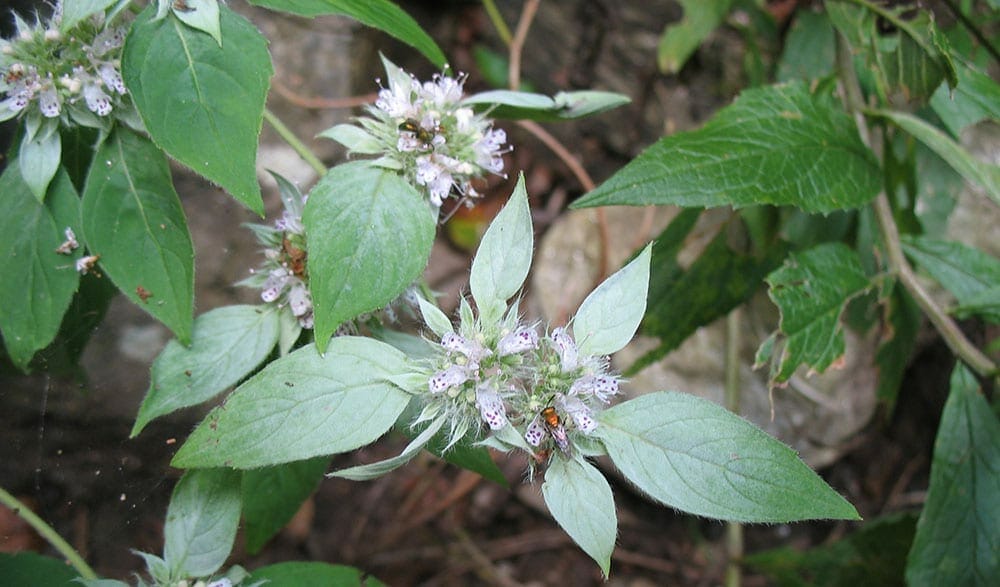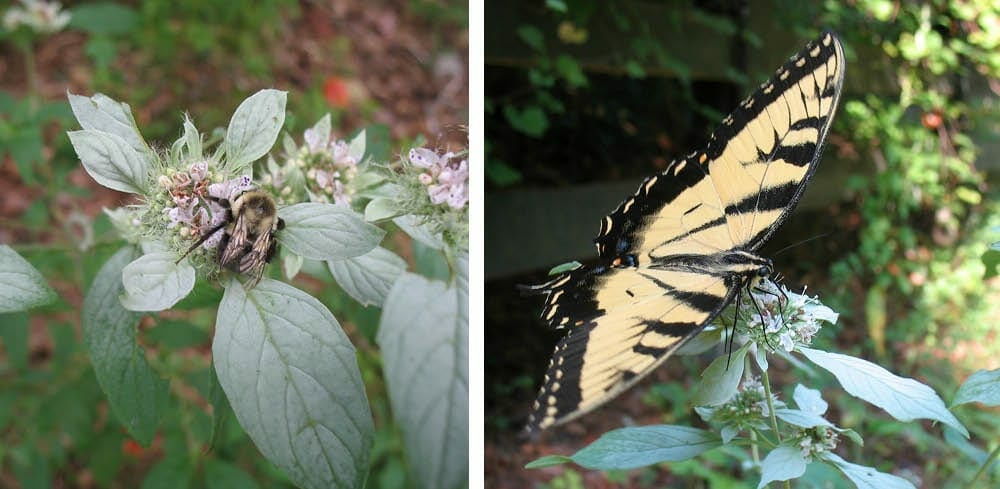2020 Plant of the Year: Southern Mountainmint
Our GNPS 2020 Plant of the Year, southern mountainmint (Pycnanthemum pycnanthemoides), is native throughout Georgia, where it thrives in meadows, roadsides, and woodland openings. Reaching 3-6’ tall, it has simple, opposite, lightly toothed leaves that are lanceolate in shape. The upper leaves, as well as the bracts beneath the flowers, are covered in short, curly white hairs. In summer, the plant looks like it has been dusted with powdered sugar.
Southern mountainmint blooms throughout the summer. Beginning in June, each stem is topped by a roughly inch-wide inflorescence of tiny, tightly clustered, irregularly shaped white flowers with pinkish-purple markings. The genus name, Pycnanthemum, comes from the Greek “pyknos” (dense), and “anthos” (flower), in reference to the packed flower heads. Within each head, individual flowers typically do not all open at the same time, but blossom progressively until early September, providing pollen and nectar for myriad insects. It is not unusual to see flower heads covered with native bees, honey bees, wasps, or butterflies. The plant is also beneficial to birds, which feed on the small oval seeds or “nutlets” that appear in autumn.
There are about 20 species of mountainmint in Georgia, and some of them can be difficult to tell apart. Southern mountainmint resembles both hoary mountainmint (P. incanum) and Loomis’ mountainmint (P. loomisii). Their foliage and flowers are similar, and they all have hairy leaf undersides and stems. However, it is possible to distinguish the species by their calices and fruits. Southern mountainmint’s longest calyx lobes are more than half as long as the calyx tube, (in P. incanum, they are less than half as long), and its nutlets are pitted (in P. loomisii, they are smooth).
Native pollinators, including bumblebees and swallowtail butterflies, are attracted to fragrent southern mountainmint. Photos, including top image, by Ellen Honeycutt.
Mountainmints (Pycnanthemum ssp.) are in the Lamiaceae family, and have many characteristics in common with true mints: square stems, aromatic leaves, hardiness, drought tolerance, and a tendency to spread. They also have medicinal, culinary, or insect repellent properties, determined at least in part by the concentrations of key oils expressed within the leaves or shoots. Some mountainmint species closely resemble one another chemically; others do not. For example, southern mountainmint, hoary mountainmint and pilose mountainmint (P. pilosum) all contain high concentrations of the aromatic oils pulegone (insect repellent) and menthone (minty, medicinal), and moderate levels of limonene (citrusy) in the shoots and/or leaves. In contrast, Loomis’ mountainmint has limonene but very little pulegone or menthone [1]. Native Americans used mountainmint poultices to treat headaches and used teas for colds and fevers. Today, various herbal websites also recommend mountainmint teas as medicines. It should be noted, however, that herbs containing pulegone should not be ingested in large quantities because of toxicity concerns and should never be taken when pregnant.
Mountainmints were first discovered by botanist Henri Michaux in the Pennsylvania mountains, hence the name. However, southern mountainmint grows well in many terrains, and can tolerate most soil types, as long as it gets good drainage and at least partial sunlight. Its striking foliage and long bloom time make it a great garden plant, albeit an eager spreader. Its silvery beauty pairs strikingly with other species having dark foliage or colorful flowers. Cut it back in winter to encourage re-growth, and enjoy this beauty, with its busy insect entourage, all summer long.
[1] Dr. Duke’s Phytochemical and Ethnobotanical Databases: https://phytochem.nal.usda.gov/phytochem


